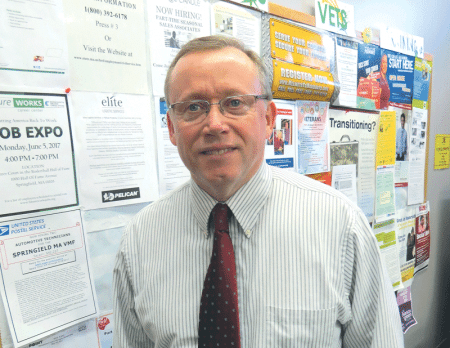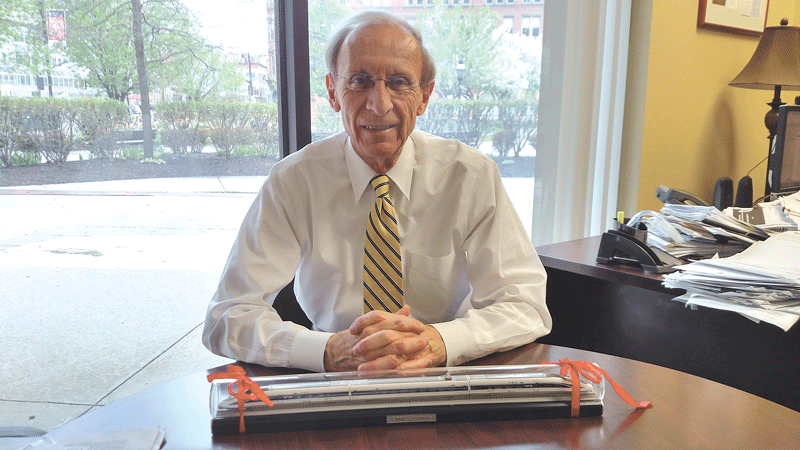Hire Expectations
The job market in the region has tightened considerably in recent years, approaching, if not reaching, that state known as full employment. In this environment, employers are finding it increasingly difficult to find good help — at least among the ranks of the unemployed — and many are responding to the situation proactively and creatively.
It was almost 17 years ago, but Kevin Lynn can still remember the sense of urgency in the employer’s voice and the impassioned plea for help — any kind of help.
“He just said, ‘get me someone with a beating heart,’” said Lynn, then (and still) director of FutureWorks, the one-stop career center based in Springfield. “That was his lone qualification; he was desperate, to be sure.”
That was in 2000, just before the recession prompted by the bursting of the tech bubble, he told BusinessWest, when the nation, and this region, were pretty much at full employment and companies were struggling mightily to find talented help.
Things are not quite that bad (for employers) or that good (for job seekers) at this moment in time, he added quickly, before offering a very intriguing, if not menacing, qualifier.
“If the economy keeps going the way it’s going, could we be there in a year? Maybe,” he said.
For now, Lynn, like others, would say merely that the job market is as tight as it’s been in a while, maybe since 2000, and certainly since the height of the last recession in 2009.

Kevin Lynn says the tightening of the job market has put many employers in a situation where they need to ‘grow their own’ talent.
At that time, he noted, there was a very large pool of talented, skilled people looking for work. Now, the pool is seriously depleted, comprised mostly of people with fewer skills, both technical and ‘people,’ and less experience than employers would prefer.
This is the main byproduct of ‘full employment.’ That’s a term used by economists and others, and it has a definition — actually several of them. The one that prevails goes something like this: ‘a state of the economy in which all eligible people who want to work can find employment at prevailing wages.’
Most economists believe full employment occurs when the unemployment rate is at or just above 4%, which, according to the latest figures, just happens to be the rate nationwide.
But from a practical standpoint, and for the purposes of this discussion, parties are more interested in what full employment, or something close to that, means figuratively, not literally.
For employers, it means challenges — everything from finding and retaining qualified help to rising wages, said Meredith Wise, executive director of the Employers Assoc. of the NorthEast.
“Employers are beginning to get frustrated with the lack of quality out there, the lack of skills out there,” said Wise, adding that this situation will, in all likelihood (meaning unless there is a dramatic downturn in the economy) become more exacerbated when MGM Springfield begins hiring people in large numbers. That should start happening about a year from now, and there should be quite an impact on the local employment picture (much more on this later).
Nearly full employment also means that many employers are becoming more creative when it comes to such matters as searching for help and developing employees’ skill sets once they arrive, Wise went on, which, overall, is a good thing.
“Employers are looking at the situation and saying, ‘well, if the regular methods for getting employees aren’t working — if I can’t just go out to the employed market — what else can I do?’” she explained. “We’re seeing employers that are trying to get more involved with the schools, trying to get more involved with interns, and other steps. Employers are sensing that, if the regular methods aren’t working, instead of just throwing their hands up and trying to steal people from others, they’re looking at what else they can do.”

Meredith Wise
Employers are telling me that the people who are walking through their doors don’t have the skills that they’re looking for.”
Lynn agreed, noting that, in many cases, employers are adopting what he called a ‘grow your own’ philosophy, whereby, instead of holding out for individuals who have the requisite skills upon arrival, they’re opting for taking rawer talent, if you will, and developing it.
He cited the staffing company Snapchef, which recently opened a location in downtown Springfield, as one that embraces a model others will likely have to follow.
“They provide a five-week training course for people who want to get into the food-service business,” he explained. “Individuals learn all the basics, and Snapchef gets people into a job; this is probably the model that more employers are going to have to embrace.”
As for the region as a whole, full or nearly full employment means working harder with those who are still in the labor pool — including some who might have given up on their efforts to re-enter the workforce and are now giving it another go — to help them attain and retain work, said Dave Cruise, executive director of the Regional Employment Board of Hampden County.
“We’re working hard with those individuals looking to re-enter the market to address barriers that might have prohibited them from getting back in,” he said. “And as we do that, we’re focused not only on identifying candidates for employers, but also on the issue of retention, and dealing with issues now, as opposed to when someone is five or six weeks on a job.”
Work Orders
Lynn calls it the ‘recruiting corner.’
That’s an area at the FutureWorks complex — a table near the main entrance, actually — where area employers will, as that name, suggests, do actual one-on-one recruiting with those who come to the agency for help attaining employment.
At the height of the recession, and in the years after it, for that matter, the recruiting corner wasn’t used much because most companies weren’t hiring, and if they were, job hopefuls were coming to them.
The situation is much different now, obviously, Lynn went on.
“We’re seeing increased demand among employers who want to come and sit there during times of high foot traffic and get some face time in front of potential employees,” he said, adding that the economy is, for the most part, solid, and many companies across a host of economic sectors, are hiring — or at least thinking about it.
 Dave Cruise says many of those who remain unemployed face one or more barriers to re-entering the workforce.
Dave Cruise says many of those who remain unemployed face one or more barriers to re-entering the workforce.
And what they’re finding as they go about hiring is that the pool of talent is shallow, that most of the individuals they would prefer to hire are already gainfully employed, and that they’re going to have to work harder and be more creative in their efforts to find and retain talent.
The resulting challenges for employers manifest themselves in many ways, from the recruiting corner to the strong interest shown in a job expo to be staged early next month at the Basketball Hall of Fame.
“We recently opened registration,” said Lynn. “And as soon as we put that out, we got three or four companies to sign up.”
Locally, as noted, the employment situation is not as tight, or robust, as it is nationally, or certainly in the eastern part of this state.
Larry Martin, director of Employer Services & Engagement with the Regional Employment Board of Hampden County, said the unemployment rate in Hampden County is just over 5%, compared to roughly 3.6% for the Commonwealth. In Springfield, meanwhile, still one of the poorest communities in the state, unemployment is at roughly 6.8%.
Both that number and the 5% for the county represent significant improvement over just a few years ago, said Martin, noting that unemployment in Springfield was well above 10% at the height of the recession.
As for the current situation and what it all means, those we talked with started by assessing the constituency that remains unemployed. This is where Cruise made repeated use of that word ‘barriers,’ adding that most all of those out of work and looking for work (some are not) generally face at least one, and perhaps several.
Wise agreed, and summoned that well-worn phrase ‘skills gap’ to describe what employers generally see or perceive from the current workforce, meaning those who are presently unemployed.
“Employers are telling me that the people who are walking through their doors don’t have the skills that they’re looking for,” she explained. “Sometimes this is in manufacturing, when people are looking for someone specific, like machine operators or maintenance people, or other roles. But other times, it’s just the general market — people walking through the doors for receptionist positions or accounting clerk, positions where you don’t need a lot of technical skills, but you need the customer-service skills and people with good work histories.
“A lot of the people who currently make up that 4% are people whose work history is maybe not that great,” she went on. “They may have moved around a lot, or they may have been out of the workforce for a while, so therefore employers are hesitant to bring them back in.”
Work in Progress
Some of those who remain unemployed are older individuals (a term usually used to describe those over 55, although the age varies), who were downsized during the recession and have often struggled to re-enter the workforce or given up altogether.
The tightening of the job market has given some of these older workers the impetus to get back in the hunt for work, said Martin, noting that some face a steep climb because their skills are outdated.
“There were a lot of older individuals who may have been in a particular industry and didn’t have the updated skills, and got discouraged,” he explained.
Wise agreed, but opined that she believes some employers are making a mistake by overlooking or perhaps underestimating some older workers and, more specifically, their desire to return to the workforce at a salary (and rung on the ladder) lower than where they were when they left.
“Employers look at some of those older workers and look at what they had been making and also at what their job responsibilities may have been,” she noted. “And they’re hesitant to bring them into their workforce now, because they’re concerned that the individual may not be satisfied — this person may have been in a managerial position or a position with some responsibility, and is now looking for a lower-level position.
“I think employers are doing themselves a bit of a disservice, because they’re bypassing those people,” she went on. “A lot of those older workers that have been in a position of responsibility … they’re done with that; they don’t want those responsibilities anymore. They want to keep working, and they’re ready to take that step back and do the 9-to-5. And many employers are overlooking those people.”
Others among the unemployed have different barriers, including everything from language to basic skills to transportation, said Cruise, adding that one of the REB’s main focal points at this juncture is working to remove some of those barriers — not just to gaining a job, but to succeeding in one and staying in it.
Elaborating, he said many individuals come to the REB looking for employment, but before they are ready to attain it, they need one or more of the other services provided by the agency — training, education, and various forms of support.
“What we’re finding is that fewer and fewer of the people coming to us are ready, based on our assessment of them, for that top bucket — employment,” he explained. “They may come in looking for employment, but we’re finding that in many cases they need training, and prior to that, they need education, such as basic mathematical skills.”
They also need some of those softer ‘people’ skills, he added, adding that the workforce of today is different from the ones years ago in that teamwork and the ability to work in tandem with others, as well as the ability to perform many different tasks, are far more important.
“It’s no longer a situation where you park your car, punch in, and go to your workstation and stay there, in isolation, until your lunch break,” he explained. “That doesn’t exist anymore, and for a lot of people trying to re-enter the workforce, it’s a matter of educating them to a different work culture and the necessity of them working in team-type situations and having the skills to move from task to task.”
Rolling the Dice
As the pool of unemployed workers shrinks and become less qualified, several forces come into play, said Wise, adding that employers must be focused not only on attaining new help, but retaining existing help.
Indeed, in such cycles, competition for those with skills and good work habits naturally intensifies as the advantage clearly shifts from employees to workers, she went on, adding that this dynamic is reflected in rising wages and benefits.
They’re not going up dramatically in this region, but they are rising, she said, noting that, while most companies weren’t giving any raises at all during the recession and the year or two after it (in fact, wage cuts were common) and then giving increases of only a percentage point or two, most are giving raises averaging 2.5% to 3%.
“That’s been pretty consistent for the past few years,” Wise said. “And in many industries, it’s closer to 2.8% or 3% than 2% or 2.5%.”
These wage hikes reflect the heightened competition for good help, said Lynn, adding, again, that in this environment, most people who are seeking employment and have desired skills are already gainfully employed.
“If you talk about people who have solid work histories and skill sets … if companies want what we’ll call a ‘fully formed’ employee, they’re pretty much looking at stealing from other employers,” he told BusinessWest. “Those who are still looking for work are facing barriers to employment, and in general, we have to train that group up to a point where they’re attractive to an employer.”
This brings him back to that notion of companies having to ‘grow their own,’ as he put it, and get someone in the door and do more training, rather than hope to find someone who already has all the requisite skills.
“I think we’re at a point where companies need to reconsider how they bring people in,” he explained. “We’re coming into a period where companies who are successful at attracting people are going to have to do more training; they’re going to have to look at people and say, ‘this person has the raw material — they may not have everything, but they have the ability to learn, and we’re going to have to grow our own.”
This situation should become more exacerbated within the next 12 to 15 months as MGM Springfield, scheduled to open in the fall of 2018, begins to assemble a workforce projected to number 3,000, said Lynn.
He said several sectors, especially financial services (bank tellers and others), food service, and the broad hospitality industry are certainly vulnerable to losing valuable employees to the casino.
And if the current trends with regard to the job market continue, backfilling those individuals lost to MGM could prove quite challenging.
“The backfill is the most crucial thing — how are we going to deal with those vacancies?” he asked. “Banks have something to worry about, based on what we’ve seen when other casinos have opened — tellers have left for those jobs because of the flexibility; you can give someone an off shift. And anything involving food and restaurants — because they’re having trouble finding people now.
“If you add another major player into the mix, and their wages are more than competitive, that will be problematic for employers,” he said, adding that their woes could be further compounded by another casino slated to open in Northern Conn.
Wise agreed, and noted that, while the casino’s opening is more than a year away, it certainly isn’t too early for employers to start thinking about what might happen and reacting in a proactive manner. Some are doing just that, she went on, but others, caught up in today, tomorrow, next week, and maybe next month, aren’t able or willing to focus on the fall of 2018 just yet.
“There are still organizations thinking, ‘I need to get through this month,’ or ‘I need to get through this year, and the casino’s not coming for another year,’” she told BusinessWest. “They’re thinking they’ll worry about that down the road, and that may be short-sighted.”
Bottom Line
Lynn said that, to the best of his knowledge, no one has called FutureWorks recently putting in an order for someone possessing only a beating heart.
The market has, indeed, tightened, but conditions are not yet approximating those of 2000 and the years that followed.
But as the steady use of the recruiting corner and the early registration for that job expo clearly show, employers are facing challenges, and they’re responding, in many cases, with creativity and maybe a mild dose of desperation.
No one really knows what will happen in the months to come, but it appears likely that conditions will only worsen — for employers, anyway — before they improve.
George O’Brien can be reached at obrien@businesswest.com


